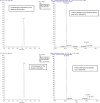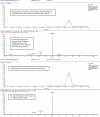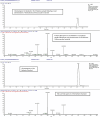Further Investigation Into an Environmental Source for Aminorex
- PMID: 39696754
- PMCID: PMC12319514
- DOI: 10.1002/dta.3820
Further Investigation Into an Environmental Source for Aminorex
Abstract
In 2009, levamisole was identified as a source for several aminorex positives reported in postrace equine samples in Canada. Since then, unexplained detections of aminorex continue to be identified in equine samples where there is no evidence to link these detections to a levamisole administration. Previous studies identified a compound named barbarin in some species of plants from the Brassicaceae family and suggested that barbarin may be a possible precursor for aminorex. The objectives of this study were to (1) investigate the link between barbarin and aminorex and (2) identify other biomarkers of plant origin. Methods were developed and validated for the detection of aminorex, barbarin, glucobarbarin, and other associated compounds. Aminorex was administered to one horse, and barbarin was not detected in any plasma and urine samples. Barbarea stricta and Barbarea orthoceras were administered to two horses, and aminorex was detected in all plasma and urine samples collected. Barbarin was detected in some plasma but not in urine samples. Resedine was observed in retrospective examination of chromatograms of the plant material and from all plants postadministration plasma and urine samples from the two horses. Resedine was administered to one horse and was detected in plasma and urine samples, but aminorex was only detected in urine samples. These results provide evidence that resedine is an intermediary compound between barbarin and aminorex in horses and that resedine can be used as a biomarker to eliminate the reporting of aminorex positives originating from the ingestion of plants from the Brassicaceae family.
Keywords: HPLC/HRAM; aminorex; barbarin; glucobarbarin; resedine.
© 2024 His Majesty the King in Right of Canada and Bureau Veritas Canada (2019) Inc. Drug Testing and Analysis published by John Wiley & Sons Ltd. Reproduced with the permission of the Minister of Agriculture and Agri‐Food Canada.
Conflict of interest statement
The authors declare no conflicts of interest.
Figures








References
-
- Loganathan D., Fu D., Zhao S., Kwan R., Chen E., and Morrissey B., “Occurrence of Aminorex and Levamisole in Canadian Racing. Part 2: Comparison of Levamisole and Aminorex Metabolism and Elimination Profiles in the Horse,” in Proceedings of the 17 th International Conference of Racing Analysts and Veterinarians (Antalya, Turkey, 2008): 204–213.
-
- Teale P. and Biddle S., “Possible Plant Sources of Aminorex and Potential Markers of Their Ingestion in the Horse,” in Proceedings of the 22 nd International Conference of Racing Analysts and Veterinarians (Dubai, 2018): 140–148.
-
- Fehey J. W., Zalcmann A. T., and Talalay P., “The Chemical Diversity and Distribution of Glucosinolates and Isothiocyanates Among Plants,” Phytochemistry 55, no. 1 (2001): 5–51. - PubMed
MeSH terms
Substances
LinkOut - more resources
Full Text Sources

